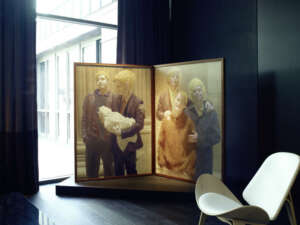
Heir
Edward Wright, 2007
Information
Heir is a striking work by the Australian artist Edward Wright, consisting of two large paintings (diptych). Using oil and acrylic on canvas, the two compositions present groups of figures with a distinctive aura and technique that characterizes the artist. Their physical presence creates a dynamic focal point in the hotel space.
Artistic Context
Edward Wright (b. 1971), a graduate of Goldsmiths College in London, is known for re-examining classical portraiture through a contemporary, often ironic and psychoanalytic lens. Influenced by the Old Masters, he adopts traditional iconography but subtly distorts it with slight shifts and exaggerations. His works appear realistic yet simultaneously contain elements of parody, dark humor, and a sense of mystery.
In Heir, Wright explores human relationships and the dynamics within a family or social group. The figures are depicted with an enigmatic expression that can suggest anything from love and care (in the panel with the infant) to a more complex and perhaps troubled relationship (in the other panel). The artist uses a translucent quality and a unique tonality to give the impression that the figures are “ghosts” of the past or memories, thus commenting on the ephemeral nature of relationships and the complexity of the emotions that govern them.
Placement & Dynamics at The Met Hotel
Heir is part of the hotel’s permanent collection of contemporary art and harmoniously integrates into the space’s unique aesthetic. Placed in a spot highlighted by natural light, it acts as a window into human stories. It encourages the visitor to pause, observe the interactions between the figures, and reflect on their own relationships and memories.
Why it deserves your attention
- Unique Technique and Atmosphere: The combination of classical technique with a contemporary translucent quality creates a dreamlike and melancholic atmosphere.
- Profound Subject Matter: The work explores human nature, relationships, heritage, and the inevitable effect of time.
- Interactive Presence: The diptych challenges the viewer to decipher the stories hidden behind the faces, making it a point of internal exploration.

